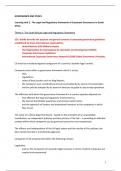GOVERNANCE AND ETHICS
Learning Unit 2 : The Legal and Regulatory framework of Corporate Governance in South
Africa
Theme 1: The South African Legal and Regulatory Framework
LO1: Briefly describe the purpose and general content of corporate governance guidelines
established by these internaLonal organisaLons:
- United NaLons (UN) Global Compact
- The OrganisaLon for InternaLonal Co-operaLon and Development (OECD)
Corporate Governance Guidelines
- InternaLonal Corporate Governance Network (ICGN) Global Governance Principles.
CG must be considered against background of a country’s boarder legal context.
Companies exist within a governance framework which is set by:
- laws,
- regulaGons,
- codes of best pracGce such as King Reports,
- the company’s own consGtuGonal structure provided by its memo of incorporaGon
- and the policies adopted by its board of directors to guide its day-to-day operaGons.
The efficiency with which the governance framework in a country operates depends on:
- how effecGve the legal and regulatory environment is,
- the level of shareholder awareness and acGvism which exists,
- and the approach of funders and insGtuGonal investors to the companies in which
they invest.
The value of a robust legal framework – based on the principles of an unassailable
consGtuGon, an independent judiciary and due process of the law – in providing an effecGve
context within which companies can be governed cannot be over-emphasised.
The efficacy and independence of the SA legal system and the resolve of the judiciary has
been tested recently in 2 landmark judgments.
Companies in SA are governed within the following context:
LegislaGon
- Such as the Companies Act provides legal structure in terms of which companies are
created and empowered
1
, - Companies are creatures of statue, and cannot exist unless they are created by law
and given certain powers in terms of their founding documents ie. The memo of
incorporaGon
- A companies memo may include certain limitaGons on the standard raN of powers
with which a company is incorporated
- Companies may also be created in terms of their own founding legislaGon, for
example the BroadcasGng Act in respect of the SA broadcasGng corporaGon
- Company law defines the manner in which the companies come into existence; it
defines their objects, authoriGes, the rights and obligaGons as separate legal enGGes;
the offences of which they are capable and the penalGes applicable to those
offences.
- LegislaGon also lays down the min requirements for reporGng by companies to their
stakeholders, determining what, how frequently and to whom info must be provided.
- Companies must also comply with a host of other laws that regulate ie. Health, safety
issues, compeGGon, markeGng and employment pracGces and tax obligaGons
- Compliance with all applicable legislaGon remains the accountability of the
company’s board of directors, although the day-to-day responsibility for this funcGon
is usually delegated to execuGve management with the board exercising an oversight
role
RegulaGon
- RegulaGon exist to assist the primary legislaGon process
- Primary legislaGon such as the Companies Act contains provisions which allow
certain bodies established under the law to make regulaGons, in terms of defined
process, on a range of maUers within their areas of responsibility
- Allows the law to be applied more effecGvely, more quickly and with the greater
flexibility having regard to changing circumstances
- RegulaGons therefore involve the prescripts of government agencies and regulatory
bodies put in place by the state for the governance of companies and the protecGon
of investors
- Include organs such as the CompeGGon Commission, the Takeover RegulaGon Panel,
the SecuriGes and Exchange commission in the US as well as authoriGes formed to
deal with specific commercial crimes
LisGngs requirements
- SecuriGes exchange regulaGons such as the JSE lisGngs requirements determine the
requirements that companies must fulfil in order to have their shares listed on a
stock exchange
- LisGngs requirements regulate the conduct of listed enGGes and companies planning
to list their shares
2
, Codes of best pracGce
- An upshot of the proliferaGon of corporate governance codes around the world has
usually been the adopGon of the codes as a precondiGon to a stock-exchange lisGng
- The UK combined code is not mandatory for listed companies, but these companies
are required to report on whether they have complied and if not, why not – the so
called ‘comply or explain’ approach
- The Singapore Stock Exchange Code was iniGally a lisGng requirement, and therefore
mandatory, but has since become a non-mandatory best pracGces guide, on a
‘comply or explain’ basis
- Revision of the JSE LisGngs Requirements following the release of the King III, it was
made mandatory for listed companies to comply with the provisions of the kind code
or to explain, in their annual reports, the extent of the reasons for any non-
compliance
- Following the release of King IV the JSE announced proposed amendments to its
LisGng Requirements which will make adherence to King IV mandatory for JSE listed
companies
- ContenGous issue at this Gme is whether the requirement of CG codes should be
mandatory or recommended only, thereby giving them the advantage of being
flexible, adaptable and responsive to changing business circumstances
- The global trend appear to be towards the development of hybrid systems, where
governance principles are increasingly being legislated
- In contrast to King II’s ‘comply or explain’ approach which implies an element of
sancGon for companies that fail to comply, King II approached governance from the
point of view that companies should apply the principles of the Code, but if they
elected not to do so, they were required to explain their non-applicaGon to
shareholders and stakeholders
- King III disGnguished between statutory provisions, which are mandatory, and
recommended governance pracGces, and made it clear that it was the boards duty to
override a recommended pracGce if the board believed that to do so would be in the
best interests of the company
- Board chose this opGon, it had to give reasons for applying its preferred pracGce as
opposed to the recommended pracGce as set out in the Code
- In Kind IV, which replaces King III, the approach has moved to ‘apply and explain’
- Companies should explain, at high level, the material pracGces they adopt in the
course of applying the CG principles of the King Report.
- Disclosure should be guided by the need to provide material, qualitaGve info,
however, rather than parroGng of principles
- King IV remains a code of recommended pracGce unless its applicaGon is made
mandatory by other law or regulaGons, for instance the JSE LisGngs Requirements
- Statutory pracGces, are mandatory for companies to which apply
3





